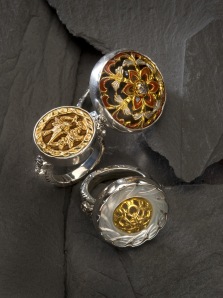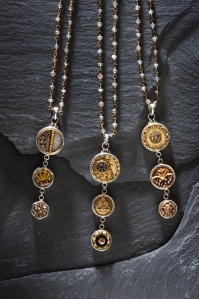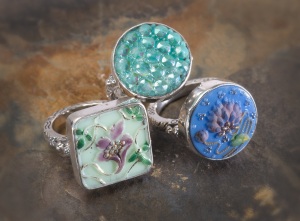Antique Button Jewelry
Elizabeth Ngo: Antique Button Jewelry
Elizabeth Ngo creates jewelry from historical works of art. Perhaps you yourself own one of these tiny historical pieces, thrown into a jar or the back of a drawer. You might have one or two tucked under your sofa cushion. The button. The simple fastener that fastens material and memories and generations. How many of us remember hours of entertainment sifting through button collections? Enjoying the feel of running our fingers through a pile spilled onto the floor. Marveling at the variety and detail. Turning to our siblings to say, “look at this one!” So often, as I stand with a customer, picking up this piece and that of the Ngo collection, I hear a story tied to memories of our mothers, our grandmothers, our younger selves.

The simple button carries a sort of sacred quality that transports us to another time. Elizabeth Ngo retains that quality by creating with great respect and attention to detail. With a profound reverence for the historical significance of each piece, she maintains the integrity of the button by leaving the shank in tack. Setting the buttons in finely worked and beautifully detailed sterling silver to create wonderfully balanced rings, bracelets, necklaces and earrings. Adding details of Swarovski crystals and semi-precious stones and the finest findings.
“I work mostly with the Victorian Glass, picturesque French Metals, carved pearls and hand painted enamel buttons from this period. They are all very unique works of art that speak about their time period. Preserving these buttons into unique pieces of jewelry is my way of putting the buttons back on the women.”
These elegant works of art reflect the era of the 1800’s in Europe. Whimsical characters, fleur de lis imagery, knights and battles, created with amazing enameling and intricate carving. Victorian glass, pearls and shells, ornate rhinestones and iridescent glass, all reflecting a time when art and history and handwork were highly revered.
The history of buttons goes back at least as far as the Satsumas, highly collectible ceramic buttons from Japan. Named for a historic ceramics center on the southernmost island of Japan, Satsumas were first made in the 17th century by Korean potters. These buttons were often painted in extraordinary detail, depicting miniature scenes from Japanese life and the natural world.
The brass picture buttons, which you’ll find in the Elizabeth Ngo collection, come from the Victorian era and are also highly collectible. Delightful pieces, stamped with charming images inspired by everything from operas to children’s books. Other picture buttons took their cues from nature (flora and fauna), the sciences (stars and moons), or mythology (cupids and fairies).
Black glass buttons from the Victorian era came next. Initially, black buttons were made out of jet, a fossilized coal found near Whitby, England. But because of the high cost of jet, black glass was soon used as a replacement.
Some black glass buttons were molded to create reliefs of plants and animals, and detailed pictorials. Some of the buttons have reliefs of fabrics patterns; others have a stunning silver or iridescent luster. You might also find some that have been painted or enameled.
Explore our cases and join in discovering the stories behind these historical pieces. Once your inner sleuth is awoken, you might check out some of these great online resources to further your adventure:
Hammond Turner & Sons online collection: http://www.hammond-turner.com/
Keep Homestead online collection: http://keephomesteadmuseum.org/button.htm
The Victoria and Albert Museum (often abbreviated as the V&A), London, is the world’s largest museum of decorative arts and design, housing a permanent collection of over 4.5 million objects. They have an online button collection that you can view at: http://bit.ly/1rXwmIB
Field Guide to Antique Buttons and Vintage Glass http://www.grandmothersbuttons.com/Images/Interior/resources/gran_fieldguide_web2011.pdf




